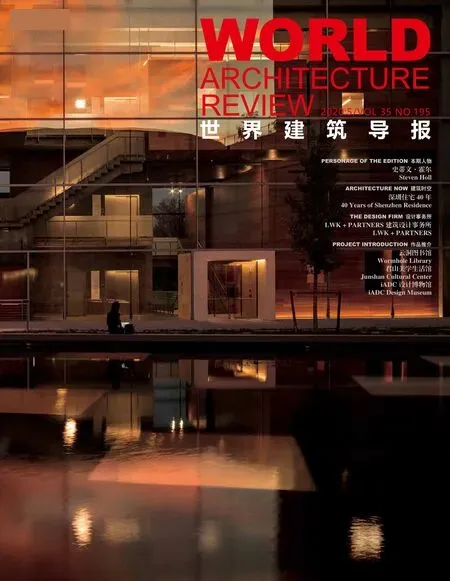肯尼迪表演艺术中心扩建项目REACH美国新泽西州,普林斯顿
建设单位:肯尼迪表演艺术中心
设计单位:史蒂文·霍尔建筑师事务所
设计团队:史蒂文·霍尔(主创设计), Chris McVoy(高级主管),Garrick Ambrose, Garrick Ambrose, Magdalena Naydekova, Bell Ying Yi Cai, Kimberley Chew,J.Leehong Kim, Martin Kropac, Elise Riley, Yun Shi,Dominik Sigg, Jongseo Lee , Alfonso Simelio
合作设计:BNIM建筑师事务所
结构工程:Silman
景观设计:Edmund D Hollander Landscape Architects Design
照明设计:L’observatoire International
建筑面积:11 570 平方呎
室内建筑面积:72 000 平方呎
景观面积:130 000 平方呎
时间: 2010年 - 2019年
Client: John F.Kennedy Center for the Performing Arts
Architect: Steven Holl Architects
Design Team: Steven Holl, Chris McVoy(partner in charge), Garrick Ambrose(design architects), Garrick Ambrose (project architect),Magdalena Naydekova (assistant project architect), Bell Ying Yi Cai,Kimberley Chew, J.Leehong Kim, Martin Kropac, Elise Riley,Yun Shi, Dominik Sigg, Jongseo Lee, Alfonso Simelio (project team)
Associate architects: BNIM Architects
Structural Engineer: Silman
Lighting Consultant: L’Observatoire International
Landscape Architect: Edmund D Hollander Landscape Architects Design
Building Area (Square Feet): 11,570sf
Building Area (Square Feet): 72,000SfInterior Space
Landscape Area (Square Feet): 130,000Sf
Year: 2012 - 2019
作为约翰·F·肯尼迪(John F.Kennedy)总统的“活纪念馆”,肯尼迪表演艺术中心在华盛顿特区众多伟大的总统纪念物中占据着重要地位。通过组织举办各类公共活动和对表演艺术活动的支持,肯尼迪艺术中心为公众提供了一个可以跟各领域中富有创造力和想象力的艺术家和表演家零距离沟通互动的机会。表演中心这次的扩建项目名为 REACH,由斯蒂文·霍尔建筑事务所主持设计。在原有艺术中心的基础上,项目主要增添了彩排空间和配套的教育空间,还有一系列方便灵活的室内外空间,以进一步巩固肯尼迪艺术中心在艺术文化领域的领导地位。
同时,REACH 的设计还将构筑物与周边景观做了一定的延展融合,对肯尼迪中心蕴含的纪念意义进行了延伸拓展。扩建项目在室外景观上对肯尼迪总统的一生做了一定的隐喻设计:由 35 棵银杏树组成的小树林会在 11 月末飘落黄叶,象征其所就任的职位是美国的第 35 任总统;而景观池甲板所运用的桃花心木材采用肯尼迪总统在第二次世界大战时指挥的 PT109 号鱼雷快艇中甲板木的材质和尺寸。
As a “living memorial” for President John F.Kennedy, the Kennedy Center for the Performing Arts takes an active position among the great presidential monuments in Washington, D.C.Through public events and stimulating art, the Kennedy Center offers a place where the community can engage and interact with artists across the full spectrum of the creative process.The REACH expansion, designed by Steven Holl Architects, adds much-needed rehearsal, education, and a range of flexible indoor and outdoor spaces to allow the Kennedy Center to continue to play a leadership role in providing artistic, cultural,and enrichment opportunities.
The design for The REACH merges architecture with the landscape to expand the dimensions of a living memorial.The landscape design includes a narrative reflection on the life of President Kennedy: a grove of 35 gingko trees, which will drop their golden autumn leaves in late November, acknowledges John F.Kennedy’s position as the 35th President of the United States; and a reflecting pool and mahogany landscape deck are built in the same dimensions and mahogany boards of Kennedy’s WWII boat, the PT109.

和爱德华·斯通(Edward Durell Stone)早先设计的肯尼迪艺术中心有所不同的是,REACH 扩建部分将三个构筑物与其周围所属的绿地景观紧密地联结在一起,旨在进一步强化建筑与周边公共空间的联系,并使其和一旁的华盛顿纪念碑、林肯纪念堂和波托马克河岸形成良好的对景关系。三个新建的建筑,在绿地下方其实是彼此相连的。新增的 72,000 平方英尺(约 6,689平方米)的室内空间主要服务于各类工作室、彩排和表演空间以及专业的艺术学习空间。这种将扩建空间藏于公共绿地底下的设计手法,在为市民提供充足绿地空间的前提下,还为室内提供了良好的景观视野。
这片开放的绿地景观全天候为来访者提供了各种尺度的公共空间。此外,建筑师还在草坪前方最大构筑物的北侧立面上,用联播投影的方法,将艺术中心内部的实时演出画面,呈现给室外的公众。这片高达 69,000 平方英尺(约 6,410平方米)的室内扩建空间,是目前华盛顿特区最大的地下景观空间。这片景观绿地会为艺术中心的各类演出和活动提供灵活多变的空间机会,并进一步促进市民的参与度和归属感。本次扩建为艺术中心未来几年,于艺术文化和公共教育领域的领导地位打下坚实的基础。
这三个由钛白板形混凝土所围合的建筑不光与室外的景观绿地有着极强的呼应关系,还在造型上有所弯曲,以为室内引入充足的自然光照。建筑师在混凝土饰面的设计上,利用了 4 英寸(约 10 厘米)厚的榫槽花旗松板,搭配内衬的CNC 胶合板。这样一来,当参观者远观时,看到的是一个整体无缝的钛白混凝土造型;而当其移步近观时,则会看到适应人体尺度的饰面木板,以反应建筑师在设计过程中的所思所感。
In complementary/contrast to the monumental original Kennedy Center building by Edward Durell Stone, The REACH’s three pavilions are fused with the landscape.They shape outdoor spaces between them, and frame views to the Washington Monument,Lincoln Memorial and Potomac riverfront.The three pavilions are interconnected below green roofs to expand the Kennedy Center’s interior space with 72,000 sf of open studios, rehearsal and performance spaces, and dedicated arts learning spaces.Embedding much of the expansion under a public landscape offers maximum green space to the community and gives landscape views from the interior spaces.
The open landscape provides both large and intimate spaces to gather and visit at all times of the day.Simulcast projections of live performances from within the Kennedy Center will be projected onto the north wall of the largest pavilion in front of a broad lawn.The landscape serves as a green roof over the interior spaces below, the largest in Washington, D.C.at approximately 69,000 sf.The varied gardens will provide opportunities for casual performances and events and other flexible locations for enhanced engagement, further positioning the Center as a nexus of arts, learning, and culture in the years ahead.
The titanium white board-formed concrete pavilions engage with the landscape, gently curving to catch natural light for the interior.The concrete finish is made up of 4” tongue and groove Douglas fir boards that lined CNC plywood forms.From a distance the concrete appears monolithic and seamless but when examined up close has the scale of wooden boards that relate to the body and hand, while simultaneously showing an imprint of the building process.



虽然这三个新建的构筑物形态各异,似乎无法用特定的几何关系去描述它们,但建筑师在其表面设计了一定的几何关系,以建立三者间的联系。具体来说,建筑师从三个构筑物的形态语言入手,利用了包括圆锥曲面和双曲抛物面在内的几何元素。相呼应的内凹曲线,将构筑物从视觉上串联在一起,并在内部分散和传播声音。而在扩建中心彩排表演区的墙面设计上,建筑师运用了一种最新研发的纹状混凝土肌理,以同步实现室内声学设计与混凝土墙浇筑的建造需求。
同时,建筑师还利用干净透明并带有一定弧度的立面玻璃,为表演中心的室内提供充足的自然光照。此外,建筑师还对一部分玻璃进行了蚀刻处理,并在层间夹入了半透明的白色薄膜,旨在使其于白天将光线引入室内,而于晚间向外发光。建筑立面的巨大玻璃,使得参观者的视线可以从室外一直延伸到室内深处,即从入口大堂穿过彩排活动区,直至另一头的河畔景观视野,旨在彻底激发室内的互动交流和活力营造。
随着 REACH 扩建部分的落成,肯尼迪表演艺术中心当年在斯通设计中所设想的波托马克河岸的室外联结部分在 50 多年后最终得以实现。同时,项目还在林荫道上方架设了一座新的人行桥,以将艺术中心、岩溪公园和乔治敦海滨公园串联在一起。肯尼迪表演艺术中心此次的扩建部分,还进一步确定了其在21 世纪甚至未来一段时间内在表演艺术中心领域的领导地位。此外,其在纪念肯尼迪总统的同时,还会将他对艺术和美国文化的杰出贡献一直延续下去。
While all different in form, resisting any defined geometric description, the three pavilions are connected through their ruled-surface geometry.This strategy creates a language of forms, from conical sections to hyperbolic paraboloids, a visual acoustics echoing across the pavilions, cupping space between them, and dispersing sound on the inside.Inside the building, a newly developed crinkled concrete texture lines the walls of rehearsal and performance spaces, integrating acoustical qualities directly within the structural cast-inplace concrete walls.
Natural light is given to all spaces via translucent, clear and curved glass.Through etching the glass, and sandwiching translucent white films between layers, luminous surfaces diffuse light deep into the interior, and glow outward at night.Windows are positioned to provide views through the full depth of the interior, from the entry lobby though rehearsal and event spaces to the river and landscape beyond, encouraging creative curiosity and dynamic interaction.
With The REACH, the Kennedy Center’s direct connection to the Potomac River is finally achieved, more than 50 years after it was lost in Stone’s initial design.A new pedestrian bridge, which appears to float over the park way, allows easy access to and from the Rock Creek Trail and the Georgetown waterfront.The newly expanded campus positions the Kennedy Center as a 21st century, future-oriented arts institution, and celebrates President Kennedy and his significant contribution to the arts and American culture.



